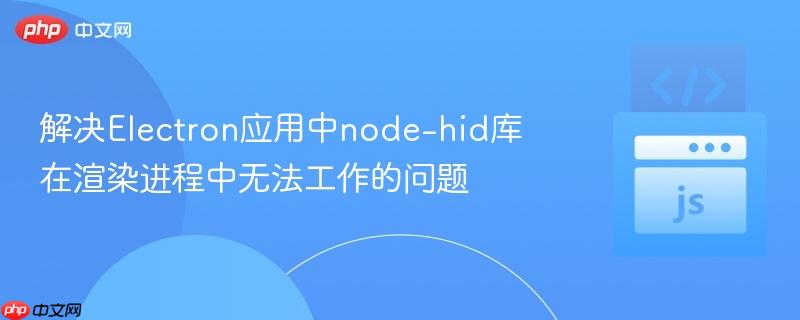
本文旨在解决electron应用中原生node.js模块(如`node-hid`)在渲染进程中无法正常运行的问题。核心解决方案是利用electron的主进程拥有完整的node.js环境优势,在此进程中执行原生模块操作,并通过进程间通信(ipc)机制将结果安全地传递给渲染进程,从而确保应用功能正常并避免“dynamic require”等错误。
Electron应用程序由主进程(Main Process)和渲染进程(Renderer Process)组成。主进程负责应用生命周期管理、系统交互和创建渲染进程窗口,它拥有完整的Node.js API访问权限。而渲染进程则是一个基于Chromium的浏览器环境,主要用于渲染用户界面,它默认不具备Node.js的全部能力,尤其是在处理像node-hid这类依赖于底层系统API或原生C++插件的模块时,会遇到“Dynamic require of 'os' is not supported”等错误。这是因为渲染进程的沙箱环境限制了对某些Node.js内置模块或文件系统操作的直接访问。
即使尝试使用electron-rebuild来重新编译原生模块以适应Electron版本,也仅仅解决了编译层面的兼容性,而无法改变渲染进程的运行环境限制。因此,正确的做法是将这些原生模块的调用放在主进程中执行。
解决此问题的核心思路是:在主进程中执行node-hid等原生Node.js模块的操作,然后通过Electron提供的进程间通信(IPC)机制将结果发送到渲染进程。
在Electron的主进程文件(通常是main.ts或main.js)中,可以像在普通Node.js环境中一样导入并使用node-hid库。我们可以在应用准备就绪后(app.whenReady())执行设备检测逻辑。
main.ts 示例:
import { app, BrowserWindow, ipcMain } from 'electron';
import * as HID from 'node-hid'; // 导入 node-hid 库
// 创建窗口函数,此处省略具体实现
function createWindow() {
const mainWindow = new BrowserWindow({
width: 800,
height: 600,
webPreferences: {
nodeIntegration: false, // 最佳实践:禁用渲染进程的 Node.js 集成
contextIsolation: true, // 最佳实践:启用上下文隔离
preload: path.join(__dirname, 'preload.js') // 预加载脚本,用于安全地暴露 IPC
}
});
mainWindow.loadFile('index.html'); // 加载渲染进程的HTML文件
return mainWindow;
}
app.whenReady().then(() => {
const mainWindow = createWindow();
// 在主进程中调用 node-hid 获取连接设备列表
try {
const connectedDevices = HID.devices();
console.log('Connected HID devices:', connectedDevices);
// 将设备数据发送到渲染进程
// 注意:这里的 window.webContent.send 应该在窗口创建后调用
// 为了确保窗口已加载完毕并能接收消息,可以稍作延迟或在渲染进程准备好后通知主进程
mainWindow.webContents.on('did-finish-load', () => {
mainWindow.webContents.send('connected-devices', connectedDevices);
});
} catch (error) {
console.error('Error getting HID devices:', error);
// 也可以将错误信息发送到渲染进程
mainWindow.webContents.on('did-finish-load', () => {
mainWindow.webContents.send('error-message', 'Failed to get HID devices: ' + error.message);
});
}
app.on('activate', () => {
if (BrowserWindow.getAllWindows().length === 0) createWindow();
});
});
app.on('window-all-closed', () => {
if (process.platform !== 'darwin') app.quit();
});
// 如果需要渲染进程主动请求数据,可以使用 ipcMain.handle
ipcMain.handle('get-hid-devices', async () => {
try {
return HID.devices();
} catch (error) {
console.error('Error in ipcMain.handle("get-hid-devices"):', error);
throw new Error('Failed to retrieve HID devices.');
}
});在上述代码中,我们使用HID.devices()获取设备列表。为了将这些数据发送到渲染进程,我们使用了mainWindow.webContents.send('connected-devices', connectedDevices);。这是一个异步操作,需要确保渲染进程的窗口已经加载完毕并准备好接收消息。
在渲染进程中,我们不能直接访问node-hid,但可以通过预加载脚本(preload.js)安全地暴露ipcRenderer模块,然后监听主进程发送过来的消息。
preload.js 示例:
import { contextBridge, ipcRenderer } from 'electron';
contextBridge.exposeInMainWorld('electronAPI', {
onConnectedDevices: (callback: (devices: HID.Device[]) => void) => ipcRenderer.on('connected-devices', (_event, devices) => callback(devices)),
onError: (callback: (message: string) => void) => ipcRenderer.on('error-message', (_event, message) => callback(message)),
getHidDevices: () => ipcRenderer.invoke('get-hid-devices') // 暴露一个方法供渲染进程调用
});renderer.ts (或 app.tsx) 示例:
import React, { useEffect, useState } from 'react';
import ReactDOM from 'react-dom/client';
// 假设 electronAPI 已通过 contextBridge 暴露在 window 对象上
declare global {
interface Window {
electronAPI: {
onConnectedDevices: (callback: (devices: any[]) => void) => void;
onError: (callback: (message: string) => void) => void;
getHidDevices: () => Promise<any[]>;
};
}
}
function App() {
const [devices, setDevices] = useState<any[]>([]);
const [error, setError] = useState<string | null>(null);
useEffect(() => {
// 监听主进程主动发送的数据
window.electronAPI.onConnectedDevices((deviceList) => {
setDevices(deviceList);
setError(null);
});
// 监听错误信息
window.electronAPI.onError((errorMessage) => {
setError(errorMessage);
setDevices([]);
});
// 也可以在渲染进程需要时请求数据
const fetchDevices = async () => {
try {
const deviceList = await window.electronAPI.getHidDevices();
setDevices(deviceList);
setError(null);
} catch (err: any) {
setError(err.message);
setDevices([]);
}
};
fetchDevices(); // 在组件挂载时请求一次
}, []);
return (
<div>
<h1>连接的HID设备</h1>
{error && <p style={{ color: 'red' }}>错误: {error}</p>}
{devices.length > 0 ? (
<ul>
{devices.map((device, index) => (
<li key={index}>
<strong>产品:</strong> {device.product || 'N/A'}, <strong>制造商:</strong> {device.manufacturer || 'N/A'}, <strong>路径:</strong> {device.path}
</li>
))}
</ul>
) : (
<p>未检测到HID设备或正在加载...</p>
)}
</div>
);
}
const root = ReactDOM.createRoot(document.getElementById('root')!);
root.render(<App />);在Electron应用中,当遇到node-hid或其他原生Node.js模块在渲染进程中无法工作的问题时,核心解决方案是遵循Electron的进程模型,将这些模块的调用移至主进程。通过主进程的Node.js环境执行底层操作,然后利用Electron的IPC机制(webContents.send和ipcRenderer.on/ipcRenderer.invoke)在主进程和渲染进程之间安全地传递数据。这种方法不仅解决了模块兼容性问题,也符合Electron的最佳实践,提高了应用的稳定性和安全性。
以上就是解决Electron应用中node-hid库在渲染进程中无法工作的问题的详细内容,更多请关注php中文网其它相关文章!

每个人都需要一台速度更快、更稳定的 PC。随着时间的推移,垃圾文件、旧注册表数据和不必要的后台进程会占用资源并降低性能。幸运的是,许多工具可以让 Windows 保持平稳运行。

Copyright 2014-2025 https://www.php.cn/ All Rights Reserved | php.cn | 湘ICP备2023035733号